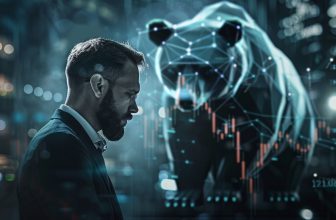Financial terminology often utilizes metaphors derived from the animal kingdom. These terms not only add color and character to the field of finance but also serve as shorthand descriptions for various market participants, strategies, and phenomena.
Let’s explore some animal-related financial terms and better understand their meanings.
What are Animal Metaphors in Finance
Put, animal metaphors in finance are terms derived from characteristics of certain animals used to describe financial scenarios or behaviors. These terms are often vivid and memorable, helping traders and investors quickly communicate complex financial ideas.
The Zoo of Financial Markets: Animal Metaphors
Let’s dive into this zoological world of finance and uncover the meanings behind these terms.

Bears
In the economic context, bears refer to investors who expect the market to decline. They believe that the prices of stocks or other assets will fall, and they may adopt strategies such as short selling or purchasing put options to profit from downward movements in the market.

Bulls
On the other hand, bulls are investors with an optimistic outlook for the market. They believe that prices will rise and actively seek investment opportunities that offer potential for growth. Bullish investors often exhibit confidence and may employ strategies such as buying stocks or call options.

Whales
Whales are large investors who have substantial holdings capable of influencing market prices. These investors possess significant financial resources, often managing portfolios of substantial size. Due to their influence, their actions and decisions can impact market trends and sentiment.

Pigs
Pigs are often associated with greedy investors prioritizing quick profits over long-term strategies. These investors tend to take excessive risks, often disregarding prudent investment principles. Pursuing substantial gains quickly may lead to significant losses if the market doesn’t meet its expectations.

Hawks
Within the financial world, hawks are economists or policymakers who advocate for high-interest rates. Their primary objective is to keep inflation under control by tightening monetary policy. By raising interest rates, hawks aim to curb excessive borrowing and spending, thereby maintaining economic stability.

Doves
In contrast to hawks, doves are economists or policymakers who prefer low-interest rates to stimulate economic growth. Doves prioritize promoting employment and economic activity over concerns about inflation. They seek to encourage borrowing, investment, and consumer spending by lowering interest rates.

Sheep
Sheep refers to investors blindly following the crowd without conducting thorough research or due diligence. They lack independent thinking and tend to make investment decisions based solely on the actions or recommendations of others. Such behavior can be risky, making them susceptible to market manipulation or speculative bubbles.

Wolves
“wolves” often describe unscrupulous or aggressive investors or traders. These individuals may employ deceptive tactics, exploit market inefficiencies, or use manipulative practices to gain an unfair advantage. The reference to wolves underscores the predatory nature of their actions.

Stags
Stags are investors who participate in the initial public offerings (IPOs) of securities to sell them quickly once trading commences. They seek to profit from the potential surge in share prices during the early stages of public trading. Stags aim to capitalize on the initial excitement and investor demand surrounding IPOs.

Ostriches
“ostrich” describes investors who ignore negative information or bad news about their investments. These individuals bury their heads in the sand, hoping the problems will vanish or resolve themselves. Ostriches are often reluctant to confront unfavorable realities, which can lead to significant losses if issues persist.

Chickens
Chickens represent risk-averse conservative investors who prefer to avoid significant market volatility. They tend to prioritize the preservation of capital over the pursuit of higher returns. As a result, they often opt for safer, low-yield investments that provide stability and peace of mind.

Dead Cat Bounce
The term “dead cat bounce” refers to a temporary price recovery following a significant market decline. Speculators or investors may buy to cover their positions, resulting in a short-lived upward movement. This phenomenon is often likened to the saying that “even a dead cat will bounce if it falls from a great height.”

Black Swans
Black swans are rare and unpredictable events that severely affect financial markets. Coined by finance professor Nassim Nicholas Taleb, this term describes events outside normal expectations and has a significant impact. Black swan events are often characterized by their retrospectively obvious but difficult-to-predict nature.

White Swans
In contrast to black swans, white swans refer to potentially severe events but are more predictable. These events are not as surprising as black swans and can be identified or anticipated to some extent. Nevertheless, if not adequately addressed or managed, white swan events can still lead to significant market disruptions or economic consequences.

Elephants
Elephants represent large institutional investors with significant financial resources and holdings, such as pensions or mutual funds. Due to the size of their investments, elephants can exert considerable influence on the market. Their buying or selling activities can move prices and impact market trends.

Snakes
The term “snakes” refers to a historical policy known as the “snake in the tunnel,” implemented in the 1970s by the European Economic Community. It aimed to maintain currency exchange rates within specific boundaries as a precursor to the modern Euro. The reference to “snakes” emphasizes the intricacies and challenges in managing currency exchange rates.

Sharks
Sharks are highly experienced and aggressive investors who seek to profit from market volatility. These investors possess extensive market knowledge, honed skills, and a keen understanding of trading strategies. Sharks are adept at identifying and capitalizing on short-term price movements, enabling them to generate substantial profits.

Snails
Snails represent slow and steady investors prioritizing consistent, incremental gains over time. While they may not make significant bets or rapid chase returns, snails adopt a patient and disciplined approach to investing. These investors often prefer less risky investments and aim to achieve steady progress toward their financial goals.

Tortoises
Tortoises epitomize long-term investors with patience and a high tolerance for market volatility. They adhere to their investment strategies over extended periods, placing trust in the power of compound interest and the historical tendency of markets to rise. Tortoises embrace a ‘buy and hold’ approach, focusing on long-term wealth accumulation.
Importance of Animal Metaphors in Finance
Incorporating animal-related metaphors into financial terminology adds a layer of vividness and relatability to an otherwise complex and abstract subject. While these terms may not be universally recognized, they serve as valuable linguistic tools that capture the essence of various market participants, behaviors, and events.
Conclusion
FAQs
Are these animal-related financial terms widely recognized?
While some terms, like bears and bulls, are widely recognized, others may be more specific to certain circles or regions within the financial industry. It’s important to ensure that both parties in a conversation understand the intended meaning when using these terms.
Can these animal-related terms help in investment decision-making?
While these terms provide colorful descriptions and insights into market behaviors, they should not be the sole basis for investment decision-making. It’s crucial to conduct thorough research, analyze data, and consider various factors before making investment decisions.
Are animal-related terms used only in the stock market?
Animal-related financial terms are commonly used in the stock market, but their usage extends beyond stocks to other financial markets and economic contexts. These terms can be applied to various asset classes, including bonds, commodities, and currencies.
How should I interpret the expanded definitions of ostriches and pigs?
The expanded definitions of ostriches and pigs highlight the negative consequences of certain investor behaviors. Ostriches ignore negative information, while pigs take the excessive risk for potentially high returns. These expanded definitions serve as cautionary reminders about the potential pitfalls in investing.
Can these animal-related terms be used in everyday conversations?
While these terms are commonly used within the financial industry, their usage in everyday conversations may vary. It’s important to consider the context and the level of familiarity of the individuals involved. Explaining the meanings behind these terms can help facilitate a better understanding of non-financial settings.






